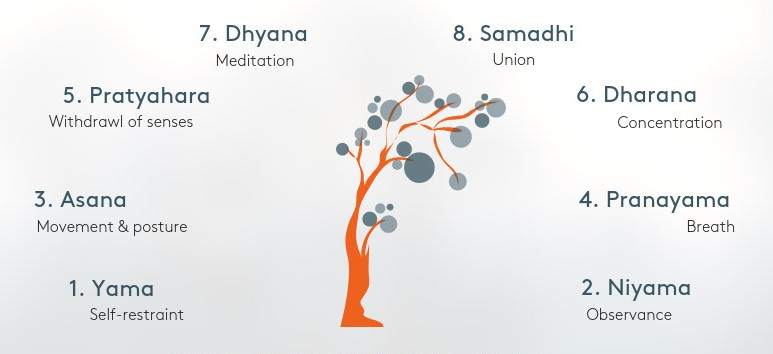The Eight Limbs of Yoga: A Path to Holistic Well-being
Introduction
Yoga, an ancient practice with roots in India, is a comprehensive system that aims to harmonize the body, mind, and spirit. The practice of yoga goes beyond physical postures (asanas) and includes a holistic approach to well-being. One of the most revered guides to understanding the essence of yoga is the “Yoga Sutras” by the sage Patanjali, which outlines the Eight Limbs of Yoga. These eight limbs offer a step-by-step path to achieving self-realization and spiritual enlightenment. This blog delves into the intricacies of each limb, highlighting their significance and practical application.
The Eight Limbs of Yoga
Yama (Ethical Disciplines)
Yama represents the ethical foundation of yoga, emphasizing moral conduct and social responsibilities. There are five Yamas:
Niyama (Self-Discipline)
Niyama focuses on self-discipline and spiritual observances. There are five Niyamas:
- Saucha (Cleanliness): Emphasizes physical and mental purity.
- Santosha (Contentment): Cultivates a sense of satisfaction and acceptance.
- Tapas (Discipline/Austerity): Involves self-discipline and commitment to personal growth.
- Svadhyaya (Self-study): Encourages the study of sacred texts and self-reflection.
- Ishvara Pranidhana (Surrender to a Higher Power): Involves devotion and surrender to a higher consciousness or divine power.
Asana (Physical Postures)
Asana refers to the physical postures practiced in yoga. These postures are designed to develop strength, flexibility, and balance while promoting physical health. The practice of asanas prepares the body for meditation by eliminating physical discomfort and restlessness.
Pranayama (Breath Control)
Pranayama involves the regulation and control of breath. It encompasses various techniques to manage the flow of prana (life force) within the body. Pranayama practices can calm the mind, reduce stress, and enhance overall vitality.
Pratyahara (Withdrawal of Senses)
Pratyahara is the practice of withdrawing the senses from external stimuli. It encourages turning inward and detaching from sensory distractions. Pratyahara helps in developing concentration and preparing the mind for meditation.
Dharana (Concentration)
Dharana involves focused concentration on a single point or object. This practice helps in training the mind to remain steady and attentive. Dharana is the precursor to meditation and aids in developing mental clarity and focus.
Dhyana (Meditation)
Dhyana is the practice of sustained and uninterrupted meditation. It involves maintaining a continuous flow of concentration without distraction. Dhyana leads to a deep state of inner peace and heightened awareness.
Samadhi (Union/Enlightenment)
Samadhi represents the ultimate goal of yoga, where the individual self merges with the universal consciousness. It is a state of profound inner peace, bliss, and spiritual enlightenment. In Samadhi, the practitioner experiences oneness with all of existence.
Practical Application of the Eight Limbs
The Eight Limbs of Yoga provide a comprehensive framework for personal growth and spiritual development. While each limb can be practiced independently, they are interconnected and support each other. Here are some practical tips for incorporating the Eight Limbs into daily life:
Start with Yamas and Niyamas:
Begin by integrating ethical and self-disciplinary practices into your daily routine. Practice non-violence, truthfulness, and contentment in your interactions and personal life.
Incorporate Asanas:
Dedicate time to physical yoga postures to improve your health and prepare your body for meditation.
Practice Pranayama:
Include breath control exercises in your daily practice to enhance mental clarity and emotional balance.
Develop Pratyahara:
Set aside time for introspection and reduce sensory distractions. Create a quiet space for meditation.
Cultivate Dharana:
Focus on developing concentration through activities like reading, painting, or practicing mindfulness.
Engage in Dhyana:
Establish a regular meditation practice to achieve deeper states of awareness and inner peace.
Aim for Samadhi:
Approach Samadhi with patience and dedication, understanding that it is the culmination of sustained practice and spiritual growth.
Conclusion
The Eight Limbs of Yoga offer a holistic approach to achieving physical, mental, and spiritual well-being. By embracing these practices, individuals can cultivate a balanced and harmonious life, leading to self-realization and enlightenment. Whether you are a beginner or an experienced practitioner, the Eight Limbs of Yoga provide a timeless guide to personal growth and inner transformation.


